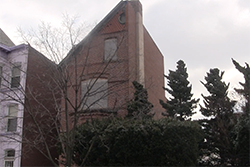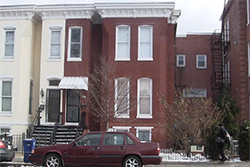Mary Church Terrell House

|
This odd looking house at 326 T Street NW was once the home of Mary Church Terrell, a courageous woman who at age 86 became the leader of the effort to integrate restaurants in the District. In 1950, she and fellow activists attempted to receive service at the segregated Thompson Restaurant on 14th Street, just blocks from the White House. After being refused service, Terrell filed a lawsuit, and continued to boycott and hold sit-ins at other restaurants while awaiting a court decision. Finally in 1953, they received the news they had dreamed of: the US Supreme Court ruled it unconstitutional to have segregated restaurants in the District. It’s from this home, which was built as a duplex and was half lost to a 1940s fire, that Terrell did much of her civil rights planning. So the next time you are in the LeDroit Park area and see this interesting-looking house, take a moment to recognize you are Walking by History.
|
Vermont Avenue Baptist Church

|
Just one year after the end of the Civil War, seven freedmen came together to start the Fifth Baptist Church of Washington, now called the Vermont Avenue Baptist Church. The founders appointed Rev. John Henry Brooks, a veteran of the Union Army, as their first pastor, and in the past 150 years only five other people have served as pastors. In 1956, Dr. Martin Luther King, Jr. came here to speak about the “Challenge of a New Age,” just weeks after the US Supreme Court had ordered the desegregation of buses in Montgomery, Alabama. And on Martin Luther King, Jr. Day in 2010, President Obama gave a speech here, and also spoke to the challenges of equality in a new age. So the next time you are near 1630 Vermont Ave NW, think about the incredible figures that have stood here to rally for civil rights, and appreciate that you are Walking by History.
|
Sixth Street Wharf

|
Between 1825 and 1860, more than 100,000 people escaped slavery using a network of paths and hideouts called the Underground Railroad. An important stop on the trail from the South to the North was the Sixth Street Wharf, which is now just a few blocks from the Waterfront Metro in Southwest. Many people escaping slavery stopped here briefly and continued the journey, but others stayed in the homes and churches of freed Black people and other abolitionists for longer. Among the most important Underground Railroad sites in the District was the home of Anthony Bowen, a man born enslaved in Prince George’s County but freed in 1830. He would meet people escaping slavery at the Wharf, and then shelter them in his home at 85 E Street SW. The home was torn down years ago to make way for what is now L’Enfant Plaza, but the importance of the site to District history endures. So the next time you are at the station or visiting the Wharf, take a moment to recognize you are Walking by History.
|
Ralph J. Bunche House

|
Ralph J. Bunche, the first African American to receive the Nobel Peace Prize in 1950, built and moved into this international style house at 1510 Jackson Street NE in 1941. At the time, the area was predominantly white, and his children were not allowed to attend the neighborhood school because they were Black. Bunche was an outspoken critic of segregation and inequality, and also a distinguished US diplomat, who won the Nobel Peace Prize for his efforts at mediating peace between the Arab states and Israel in 1949. He also was instrumental in developing the United Nations and in drafting the UN charter, before becoming undersecretary general of the UN in 1968. So the next time you visit the Brookland neighborhood, take a detour past the house of this Medal of Freedom winner, and understand that you are Walking by History.
|
Engine Company No. 4

|
In 1918, Private Charles E. Gibson, one of the few Black firefighters employed by the DC Fire Department, successfully petitioned the department to start an all-Black firefighting company. A year later, Engine Company No. 4 became the first all-black company in the District, with 15 employees and a firehouse in Southwest. The successful firefighting company continued to grow, and in 1940, it moved to 931 R Street NW, which remained its home until the DC Fire Department was desegregated in 1962. Although now a private residence, the home still looks like the thriving firehouse it once was. So the next time you are in the Shaw area and see this unique looking building, take a moment to recognize you are Walking by History.
|
Duke Ellington House

|
Music legend Duke Ellington – who gained national and international recognition throughout his 50 year career – grew up in several houses throughout Northwest DC during the early 1900s. From 1910 to 1914, still just a boy, he lived at this house at 1805 13th Street NW. In 1915 he moved across the street to another house at 1816 13th Street NW. Despite hitting it big after moving to Harlem in 1924, Duke Ellington would contribute his success to his parents, his teachers and the District, where he would frequently return to and perform. So the next time you are heading down 13th Street just a couple blocks from the U Street Metro, take a moment to recognize you are Walking by History. |








